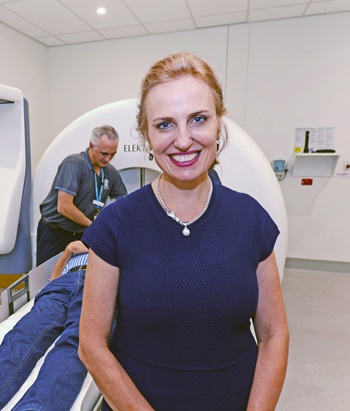2024 | Volume 25 | Issue 5

Neurosurgery pioneer Associate Professor Sarah Olson uses cutting edge robotic treatments to improve the experience and outcomes of patients.
It is the first time in the Southern Hemisphere that robot-guided laser therapy has been used in the treatment of brain tumours. The therapy involves making a tiny incision—smaller than the tip of a pencil—and placing a laser fibre inside a tumour, which the heat from the laser kills.
As one of only 42 women neurosurgeons in Australia, it is not the only time in her career Associate Professor Olson has broken down barriers.
She grew up in the small town of Hokitika in Aotearoa New Zealand’s Te Waipounamu South Island, where she continues to return to visit family and indulge in her passion for fishing.
As a school student she was attracted to medicine and engineering, and she remembers sitting on the river rocks and thinking which path to choose. She decided that medicine would provide greater opportunity to help people. She was also inspired by a woman doctor who seemed omnipresent in the small town where she grew up.
“There was a GP here who worked around the clock. Everyone knew her and where she was—even when she was home, she was still on call. She was amazing.”
The notoriously difficult specialty of Neurosurgery appealed to her love of a challenge. After training in Ōtepoti Dunedin and Waitaha Canterbury in Aotearoa New Zealand, Associate Professor Olson was attracted to a role in Townsville that involved occasional work in Palm Island—a location that wasn’t the idyll she expected.
Early in her training and career, she was determined to forge her own path but was often underestimated, disregarded or marginalised.
Associate Professor Olson considers this bias in the profession to be one of the main reasons so few women pursue careers in Neurosurgery.
“People were very surprised that I was entering Neurosurgery. I was at someone’s 50th the other night and a guy said they’d all looked at me—this girl who wanted to do Neurosurgery, and had taken bets that I wouldn’t last three months.”
Associate Professor Olson describes her early career as being “horrendously hard” due to the attitudes of some members of the profession and a workload that involved being on call 365 days a year. However, she also recognises the vital role that some extraordinary mentors played in her career promoting women in neurosurgery across Aotearoa New Zealand and Australian hospitals.
Despite the challenges of her role, Associate Professor Olson continues to appreciate the opportunity to care for her patients.
“When a patient dies unexpectedly, it's really, really hard to bear and it takes a little bit of your soul every time. But mostly, it is a privilege to look after patients and to get to know their families and to do your best for them.”
She is optimistic about the innovations happening in medicine and neuroscience and their impact on patients’ lives.
“I remember nearly falling off my seat at a melanoma conference about eight years ago when they were describing metastatic melanoma becoming like a chronic disease, rather than killing people within a year.
“It's just an extraordinary change that I never thought I'd see in my lifetime and we’re going in the same direction with many cancers.
“There are some new drugs out this month which are really exciting for primary brain tumours and I hope they’ll be a game changer.”
Unfortunately, not as much progress has occurred in the number of women entering Neurosurgery.
The mother of three believes a change in attitudes towards success is needed among surgeons to recognise the important role of life outside work, including family responsibilities.
Making equal paternity and maternity leave available and viable for surgeons would recognise the importance of this role and create a more level playing field for women entering the profession.
She also believes that surgeons need to re-evaluate the traits that are valuable and place a greater emphasis on compassion, communication and empathy, which she describes as women surgeons’ “superpowers”.
Despite the busy-ness of her work, Associate Professor Olson prioritises spending time with her family, and enjoys running, hiking and, when she is in Aotearoa New Zealand, fishing for whitebait.
She has a love of Tudor history and also plays the piano and is considering restudying for her final classical piano exams.
Her advice for junior neurosurgeons is to continue to learn about alternatives to mechanical Neurosurgery that can improve the quality of life and outcomes for patients.
“Think outside the square of mechanical Neurosurgery and start learning about areas that are showing so much promise for our patients, like more minimally invasive peripheral nerve treatments, focussed radiation and interventional neurovascular work—doing things that aren’t necessarily opening up brains
“These are very helpful to our patients and may not be seen as traditionally being part of Neurosurgery,” she says.